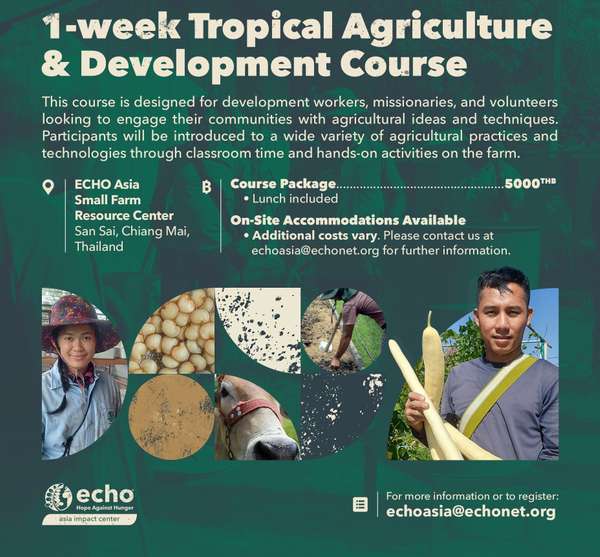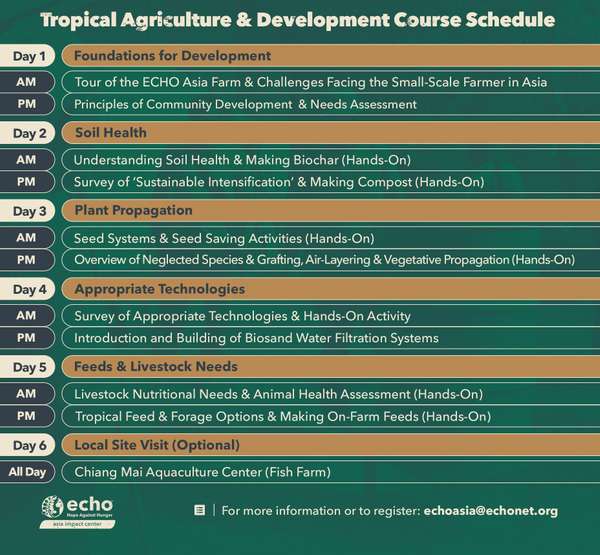-
17/09/2021 This presentation gives you an introduction to the Biochar production process and uses of biochar in small scale farming. This presentation was given at the ECHO Asia Small Farm Resource Center on 17 September2021.
-
-
19/05/2022 This is an introductory overview of Integrated Pest Management as a management system and includes a summary ofprevention, cultural, physical, biological, and chemical controls.
-
19/05/2022 A quick overview of the different categories of common crop pests and diseases, and tools for identifying them.
-
-
This presentation was given during the Seed Saving Fundamentals workshop at the ECHO Asia Small Farm Resource Center. This presentation discusses the current state of seed saving, how to classify seeds, seed types, and seed production.
- Aussi disponible en:
- ไทย (th)
- English (en)
-
-
08/04/2022 This presentation shows the importance of considering other means of feeding livestock, components of different feed requirementsfor different livestock (pigs, poultry, fish, ruminants), and how to perhaps develop a fully nutritious and cost efficient on-farm feed.
-
-
20/01/2001 SRI involves the use of certain management practices which together provide better growing conditions for rice plants, particularly in the root zone, than those for plants grown under traditional practices. We recently learned about a method of raising rice that produces substantially higher...
-
20/07/2008 This method is designed to allow crops to be grown even onsteep hillsides with minimal erosion while at the same timeincreasing soil fertility and providing fodder for livestock.Rather than controlling erosion with rock terraces or ditches, SALT relies on rows of vegetation.
-
This article is from ECHO Asia Note #30 Editor’s Note: Peter is a freelance consultant based in Chiang Mai, Thailand, with a M.Sc. in Agriculture from Leipzig, Germany. Peter is a former researcher in “The Uplands Program,” a collaborative research program between Hohenheim University (Germany),...
- Aussi disponible en:
- ភាសាខ្មែរ (km)
- ไทย (th)
- မြန်မာ (my)
- Bahasa Indonesia (id)
- 汉语 (zh)
- English (en)
-
This article is from ECHO Asia Note #29 The old adage ‘You can’t fix a problem if you don’t know you have one’ underpins the basic science of diagnosing plant nutrient deficiencies. For years, farmers and scientists have worked together to identify a set of visual clues that can be used to...
- Aussi disponible en:
- ไทย (th)
- ភាសាខ្មែរ (km)
- 汉语 (zh)
- Bahasa Indonesia (id)
- မြန်မာ (my)
- English (en)
-
Ressource principale01/01/2010 On n‘a pas beaucoup réfléchi à la pertinence de ces méthodes. Les espèces indigènes furent généralement rejetées et considérées comme des broussailles «inutiles.» Cherchant à établir des forêts, de nombreux projets ont même éliminé ces «broussailles inutiles» au profit d’espèces exotiques....
- Aussi disponible en:
- Kiswahili (sw)
- Español (es)
- English (en)
-
Ressource principale28/09/2016 Les agriculteurs dans de nombreuses régions du monde, en raison de la croissance de la population humaine, n’ont guère d’autre choix que de cultiver leurs terres en permanence, ne disposant pas suffisamment de ressources pour remplacer les éléments nutritifs retirés par chaque culture successive....
- Aussi disponible en:
- Español (es)
- English (en)
-
Ressource principale01/01/2012 Dawn Berkelaar a écrit un article sur ce système agricole dans le numéro 98 d’EDN, en collaboration avec Martin Price et Danny Blank. À l’époque, cette technique s’appelait « Culture à la mode de Dieu » (Farming God’s Way, FGW). Par la suite, ce nom a été remplacé par « Fondements pour l’...
- Aussi disponible en:
- Español (es)
- English (en)

